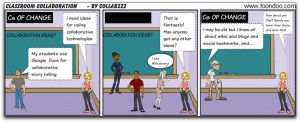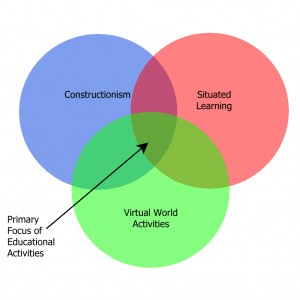Justin Reeve
This user hasn't shared any profile information
Posts by Justin Reeve
The Importance of Student Reflection
0In an online classroom, there are two primary written reflection tools: blogs and forums.
A forum is ideal for collaborating in a group, and following prompted topics. For example, a history instructor teaching a unit on the U.S. Civil War may post weekly discussion questions like:
- Why do you think it took hundreds of years for slavery to become such a divisive issue?
- How did women contribute to the war efforts?
- How did the abolitionist movement begin?
From these questions, a very lively and thought-provoking discussion may occur among the students. Each shares their own input, responds to others, and contributes by drawing from their existing knowledge and experience. It’s an excellent activity for hybrid learning environments, and directed online classes.
Forums work well for self-directed classes, too, where students work at their own pace. While you can’t guarantee that every student will progress the same through the course, thoughtful forum-based questions can cause the student to continually think about the general topics at hand. It is not unusual for forum topics anywhere on the web to be rekindled one or two years after they go silent, often by an enthusiastic or curious contributor. The advantage of the forum is that it doesn’t have to be limited in time.
In this sense, the forum acts somewhat like a blog. Student A responding to a post that Student B made a year ago probably won’t hear anything back from the Student B, since Student B likely completed the course a long time ago. But Student A still gains valuable reflection from writing. Especially in a K-12 environment where safety policies may prohibit teachers from endorsing student blogging, a closed forum hosted on the LMS can be a welcome, viable alternative.
Dawley (2007) wrote, “The asynchronous nature of discussion forums provides opportunity for in-depth reflection over time. They also create a sense of community through discussion of course concepts, peer interaction and feedback, making instructor feedback visible to all students, and they also exemplify one of the highly touted benefits of online learning — anywhere, anyplace, anytime” (p. ix).
A blog is a reflection tool that doesn’t need strictly directed prompts. When students blog, they are writing to the world, and inviting comments from people all over, not just their classmates. Using blogs gives the students ownership of their content, and lets them engage a worldwide audience, not just their teachers and classmates. Plus, many students who are shy in face-to-face settings and never speak up in the classroom, finally find they have a voice and can assume a vibrant, charismatic persona they would never seem to be able to do in a face-to-face class session (Ferdig & Trammell, 2004).
References
Dawley, L. (2007). The Tools for Successful Online Teaching (1st ed.). IGI Global.
Ferdig, R. E., & Trammell, K. D. (2004, February). Content delivery in the ‘blogosphere.’ T.H.E. Journal, 31(7), 12-20.
E-Learning Courseware Tools
1An online classroom offers more provisions to use web-based tools than a face-to-face classroom might. For Weber Online, we are using the Utah Electronic High School’s (EHS) curriculum, but our plan is to “update” it to model better practices, and Web 2.0, which have gotten increasingly sophisticated, will undoubtedly play an important role in this. Modern students, both young and old, thrive with richly interactive web tools, especially as the next generations will be increasingly comfortable and familiar with interactive web-based environments.
Udutu
Udutu is a courseware development tool that allows the teacher to make non-linear Flash-based lessons with multimedia, quizzes, and activities. The lessons are far more visually appealing than simply reading a giant page of textual information, which is how EHS courses are currently set up. Thought-provoking activities such as roleplays are ideal for Udutu lessons. What’s more, you can import Flash (SWF) files into the course you develop, which opens up numerous possibilities to integrate Udutu with other Web 2.0 tools, and existing materials on the web.
For example, typing “photosynthesis filetype:swf” will yield a number of Flash animations that could be imported for a lesson on plants, such as http://dendro.cnre.vt.edu/forestbiology/photosynthesis.swf Searching for “nuclear fission filetype:swf” yields a number of good animations on nuclear fission, such as http://www.british-energy.com/swf/fission.swf. Before importing anything, it is a good idea to make sure you’re not running afoul of copyright and fair use restrictions, and make sure you include a link to the source.
Animoto
If you have a segment of your lesson that’s heavy on photos or short videos, you can use Animoto to create an eye-catching musical video with interspersed text, and add this to a Udutu page. It only takes a few minutes to design a video with Animoto, though you may have to wait awhile for it to fully render it. Make sure you sign up with Animoto for Education to take advantage of the special longer videos they offer to teachers, for free.
ToonDoo
 ToonDoo is a comic strip creator. Students may respond to instructional material better when a virtual character is guiding and co-learning the material with them (Spierling, 2005). ToonDoo allows you to place virtual characters in scenes, arrange relevant props around them, then use captions to share instructional content. Due to the limited-text nature of comics, these shouldn’t be used as the primary tool in delivering instructional material, but to emphasize key points of lessons conveyed through other more conventional means, such as text, audio, etc.
ToonDoo is a comic strip creator. Students may respond to instructional material better when a virtual character is guiding and co-learning the material with them (Spierling, 2005). ToonDoo allows you to place virtual characters in scenes, arrange relevant props around them, then use captions to share instructional content. Due to the limited-text nature of comics, these shouldn’t be used as the primary tool in delivering instructional material, but to emphasize key points of lessons conveyed through other more conventional means, such as text, audio, etc.
References
Spierling, U. (2005). Beyond virtual tutors: Semi-autonomous characters as learning companions. ACM SIGGRAPH 2005 Educators program, SIGGRAPH ’05. Los Angeles, California: ACM.
Five Challenges to Online Education
1We are gearing up to launch Weber Online, our school district’s new web site for fully online courses. We’ve been using Moodle as a hybrid learning environment in our junior and high schools for a few years now, and the online courses will use the same system. With the assistance of a counselor, Weber School District students will be able to register for courses such as Fitness for Life, Physics, Biology, Earth Science, Anatomy, and more to accelerate their learning process, and possibly graduate early.
This is a new frontier for Weber School District, and there will be some hurdles to overcome. Few, if any of our teachers have direct experience with teaching in a fully online environment. Watson (2007) identifies five major challenges that schools and districts often encounter when implementing online courses.
Many parents, administrators, educators, and legislators do not fully understand online education
In 2006, Michigan became the first state in the U.S. to mandate virtual K-12 learning, requiring that each student take at least one online course before graduation. Others states followed in the years after. With Utah Senate Bill 65, a statewide online education network was ratified, yet the community is still somewhat divided on the issue.
 Generally people see anything that can aid a student’s education as a positive thing, but the problem is that people often don’t understand the ramifications of online learning. Is it really that different from a traditional classroom? How does a student communicate with the teacher? Some people think online learning constitutes a “teacher-less” or “self-directed” learning environment. Recent changes to Utah’s law has K-12 students registering for online courses in “windows” of enrollment each semester, rather than an anytime free-for-all, suggesting that a progressive model of learning in the collaborative social environment similar to a traditional classroom can be used. As Dawley (2007) demonstrated, online group learning gives students a stronger sense of community, instills enthusiasm and motivation with coursework, addresses multiple learning styles, reduces feelings of isolation, and gives opportunities to gain experience in using teamwork in testing real-world practices, a critical trait for functioning in the modern workplace (p. 98).
Generally people see anything that can aid a student’s education as a positive thing, but the problem is that people often don’t understand the ramifications of online learning. Is it really that different from a traditional classroom? How does a student communicate with the teacher? Some people think online learning constitutes a “teacher-less” or “self-directed” learning environment. Recent changes to Utah’s law has K-12 students registering for online courses in “windows” of enrollment each semester, rather than an anytime free-for-all, suggesting that a progressive model of learning in the collaborative social environment similar to a traditional classroom can be used. As Dawley (2007) demonstrated, online group learning gives students a stronger sense of community, instills enthusiasm and motivation with coursework, addresses multiple learning styles, reduces feelings of isolation, and gives opportunities to gain experience in using teamwork in testing real-world practices, a critical trait for functioning in the modern workplace (p. 98).
The problem is that teachers transitioning to online instruction are often at a loss in how they must shift their pedagogy. How do we assess learning? Should we just give quizzes to our students the same way we do in traditional classrooms? Studies suggest that students do perform better with online tests, rather than paper tests (MacCann, 2006). But just because Moodle provides the ability to give online quizzes, shouldn’t lead teachers to believe they are a necessary component of online assessment (Dawley, 2007). “Authentic assessments such as projects and portfolios help students develop real world skills and empower them to take responsibility for their own learning” (Dawley, 2007, p. 174). Online courses have a tendency to thrust students into the position of being more responsible for their own learning anyway.

Current growth trends indicate that 50 percent of all courses in grades 9-12 will be taken online by 2019.
The growth in online education has outpaced education policy and processes
How do we regulate what students are doing online? It has been a long-standing policy of Weber School District that official student-produced work on the Internet must have a teacher backing it. For example, students can’t upload their own videos to WeberTube. A teacher must do it for them. Likewise, can an online teacher request that students produce an online public portfolio as part of their coursework, or must all course materials be kept within the LMS? I’ve written before about student blogging (Why Teachers Should Encourage Students to Blog), but I left out this problematic policy. In Weber School District, teachers are on their own if they want to use Edublogs or a similar system to set up student blogs, but as district policy we discourage anything that in which student work is published without a teacher approving it first. A teacher could set up a fully-moderated blog that meets all these requirements, but this would be using third-party tools, so they’d receive no official support from the district.
And what happens when students outside our district start enrolling in our classes? What jurisdiction do we have over them? How will they integrate with our student system, which was initially designed for in-district students only? How will our online reporting data synchronize with other districts? Questions such as these must be addressed as we move forward.
 Funding for online students and programs has not been resolved
Funding for online students and programs has not been resolvedIt costs money to educate our students. If students start taking one or two extra courses each semester than we originally allotted for them, how will we reconcile this when we carefully analyzed the funding and distribution of assets in our district? How much is the state going to “chip in” to resolve this discrepancy, and will it be enough?
Equal access remains a challenge
Not every family in Weber School District has a computer, let alone high-speed Internet access. While the digital divide is constantly closing, teachers must be aware of some of the challenges. Weber School District does a great job of providing technology and computer lab resources to all its students, but if a student is trying to take an online course from home on a dial-up connection, it hardly makes sense for the teacher to incorporate video lectures and material, as these would take a frustratingly long time to download. Teachers wishing to include multimedia in their courses should survey their students before the course starts to make sure technology gaps don’t exist.
Determining the proper role of technology in education
Technology is only as good as the students and teachers using it. Our students are being trained to be productive, effective members of the community in the 21st century world. Workplace skills require adeptness with technology tools, and our “digital natives” are already intimately familiar with many of the tools. The role of the teacher should be to educate these students in how to use these tools to create stimulating learning experiences, and how they can impact how the students function and perform in real-world situations.
References
Dawley, L. (2007). The tools for successful online teaching. IGI Global.
MacCann, R. (2006). The equivalence of online and traditional testing for different subpopulations
and item types. British Journal of Educational Technology, 37(1), 79-91.
Watson, J. (2007). A national primer on K–12 online learning. Washington, DC: North
American Council on Online Learning.
OpenSim and Moodle: Creating Enhanced Learning Spaces
0Using OpenSim virtual world software and the Moodle LMS system, you can enhance standard course offerings. This video example show how lessons become learning spaces, objects interaction with users and other virtual world concepts. This video utilizes ExoSpace, an OpenSim world used to teach online security concepts.
Source: http://www.youtube.com/watch?v=bubAl-eg0jc
A Glog About TinyChat
1TinyChat is a web-based collaboration tool that integates video, audio, and text-based chat, plus some features such as collaborative whiteboarding and multi-user document authoring, similar to Google Docs. One of my gripes about Skype has always been that it doesn’t allow multi-video chat sessions. TinyChat is a good solution for those who require this, but don’t want to pay extra for something like ooVoo when they need larger video conferencing.
One of the strengths of online communication is having a variety of ways to converse. People have different comfort levels with different forms of communication. Some are more articulate in text, while others are better with voice. The two can be mixed together in the same session, with the same end result. Providing different options takes a step toward equalizing the playing field, empowering users with a stronger ability for communication.
On the other hand, I’m not terribly impressed with TinyChat’s inability to archive sessions, though this is perhaps something easily overlooked if someone is tech-savvy enough. A simple text copy/paste and Audacity recording can work well enough to overcome this. A screen capture with a tool like Camstudio can be used if video archiving is necessary.
Online Faculty Professional Development
0As online education continues to grow, it is increasingly necessary that faculty members are trained in the appropriate instructional practices. Adjunct faculty, with their diverse skills and backgrounds, comprise the fastest-growing group of higher education employees. McDaniel & Shaw (2010) emphasize the importance of a focus on evaluating teacher performance and determining if instructors are equipped to teach online. A commitment to consistent training is crucial for fostering lifelong learning. These aspects are critical for any organization, and “all organizations should have an agenda and strategic plan aimed toward promoting change” and a method for providing “training and development in order to achieve these goals” (McDaniel & Shaw, 2000, p. 5).
With the continued widespread growth in online course offerings, it’s only a matter of time before nearly every course will have an online counterpart, so instructors must be educated in online instructional practices. In some cases, an organization’s accreditation status can even be put in jeopardy if professional development programs are not sufficiently in line with the mission of the institution.
The emphases on evaluation and lifelong learning are important points to which any organization utilizing or implementing online training should adhere. Institutions should conduct quality assurance reviews to ensure faculty possess the proper skills for online education.
References
McDaniel, H., & Shaw, M. E. (2010). Online adjunct faculty professional development and training in higher education. Journal of eLearning and Online Teaching, 1(5).

Shifting Toward Best Practices in Online Learning
6 Utah Senate Bill 65 was recently passed, which establishes a statewide online education network, where students can earn credits from different schools. As a result, our attention has shifted toward fully online courses and how we can implement them, and how we can improve our existing hybrid courses.
Utah Senate Bill 65 was recently passed, which establishes a statewide online education network, where students can earn credits from different schools. As a result, our attention has shifted toward fully online courses and how we can implement them, and how we can improve our existing hybrid courses.
There are a good number of teachers in Weber School District using Moodle, but we’re struggling with getting teachers over the learning curve. And the problem is the same as one identified by Lane 2009. For our teachers, Moodle is a counterintuitive interface which “stops Web novices in their tracks” (p. 4). “Educational technologists look at a [course management system] and see its many features, but faculty see an inflexible system that cannot be customized” (p. 6). There are probably very few teachers in our district that have taught in a fully online learning environment, let alone do so effectively by adjusting their pedagogy accordingly.
I realize Moodle is frustrating for some of our teachers, but I also realize now that it’s our fault. We handed them a default course template that does not adopt best practices in online learning. Moodle’s topical format isn’t particularly pretty, and I’ve seen some teachers’ online courses that scroll forever downward with a neverending pile of assignments and resources. It is, quite frankly, confusing. As a result, we are redesigning the Moodle course format and implementing our own. The goal is to make an interface that’s more intuitive for novice online/hybrid teachers, makes it easier to navigate for students, and encourages stronger constructivist methodologies in the instructional practices.
What Utah is doing right now with online courses, I imagine one day will happen with professional development, even if not formally mandated. If we can share educational courses for K-12 students statewide, why not the same for teachers? There are many similarities and best practices we can identify in both K-12 and adult online courses, such as a strong focus on collaboration — the lack of a physical social presence necessitates a stronger cyber-social presence. Teachers should encourage discussion among students, and give numerous opportunities for interaction and collaborative learning. And as noted in a study by Arbaugh (2000), students in web-based courses conversed more than the old brick-and-mortar classrooms (as cited in Ternus, Palmer, & Faulk, 2007).
Collaboration was the primary focus in our Moodle class at the BrainBlast conference last summer. Yet as I discovered in my recent evaluation of Moodle, there has been little to no change in how our teachers use Moodle for collaboration. If it’s true that in the hybrid course, we must meet best practices for both online learning and classroom learning, then we need to place more focus on the online learning space in Moodle, and use it as a constructivist learning environment, rather than just a repository for stashing assignments and quizzes (Ternus, Palmer, & Faulk, 2007). Likewise, any future online professional development class we build must follow the same standards of highly constructivist learning if it is to truly succeed.
References
Arbaugh, J. B. (2000). Virtual classroom characteristics and student satisfaction with Internet-based MBA courses. Journal of Management Education, 24(1), 32-54.
Lane, L. M. (2009). Insidious pedagogy: How course management systems affect teaching. First Monday, 14(10).
Ternus, M. P., Palmer, K. L., & Faulk, D. R. (2007). Benchmarking Quality in Online Teaching and Learning: A Rubric for Course Construction and Evaluation. Journal of Effective Teaching, 7(2), 51-67.
Related articles
- A blend of Moodle and Web 2.0 technologies (cruiselyna.wordpress.com)
- Can I look at your Moodle……please? (edugeek.net)
- Merits of Moodle (weber.k12.ut.us)

A Quality Learning Experience
1Halfway through my first semester of the EDTECH program at Boise State, I realized that I was going to have a high-quality online learning experience, because online teaching is a chunk of what the program is about. The professors practice what they preach. The two ingredients for me that have made the program a success so far are the engagement and the project-based learning.
My first memories of online courses date back to about 2001, when my undergraduate school was first implementing online learning. It was a prime example of what not to do: no collaboration, faulty assessment tools, and no interaction with the teacher. There were few, if any opportunities to interact with the other students online. The assessments were basically just the same quizzes used in the brick-and-mortar version of the class, but with a time limit slapped on and the ability to “cheat” by reading your textbook. And the teacher was unavailable, and wouldn’t respond to emails for three or four days at a time.
Contrast that with the highly constructivist, collaborative, project-based learning model Boise State’s EDTECH program has adopted in its classes. It is an engaging experience. I’m finding that I’m learning and retaining more knowledge than I have before. The collaboration is invaluable as I develop and refine my projects, not to mention the enjoyment that comes from sharing one’s hard work with peers. Being able to create projects that I can directly use in my own line of work is motivation to finish them and do my best. For me, at least, I consider that an indication of this instructional model’s efficacy.
In our school district’s summer technology conference, all learning follows a similar hands-on learning model. Participants are expected to create content, rather than simply learn about it. There is still an approach where the instructor is more a lecturer than a facilitator, but every participant sits at a computer, learns about the technology tools, and constructively uses them during the instruction.
Related articles
- Project-Based Learning (taraprogram2011.wordpress.com)
- Student Perspectives on eLearning: Not Just an Education but a Way of Life (einsights.typepad.com)

K-12 Horizon Report 2011
The NMC Horizon Project identifies and describes emerging technologies likely to have a large impact on teaching, learning, research, or creative expression within education around the globe.
A Theoretical Model for Virtual Worlds in Weber School District
0 I’d like to implement virtual worlds in Weber School District. Hopefully, I’m in a position to actually steer things in this direction, and make it happen and get beneficial results. My concern with the implementation is that Second Life itself has a minimum age of 16. Great for high school kids, but it leaves out anyone younger. Plus there’s safety and security policies in place that make it complicated. However, if we used OpenSim or another third party, self-hosted virtual world solution, we could have complete control over the server, albeit at a loss of the rich content in Second Life. In essence, we’re starting from scratch.
I’d like to implement virtual worlds in Weber School District. Hopefully, I’m in a position to actually steer things in this direction, and make it happen and get beneficial results. My concern with the implementation is that Second Life itself has a minimum age of 16. Great for high school kids, but it leaves out anyone younger. Plus there’s safety and security policies in place that make it complicated. However, if we used OpenSim or another third party, self-hosted virtual world solution, we could have complete control over the server, albeit at a loss of the rich content in Second Life. In essence, we’re starting from scratch.
This is why we must adopt a constructionist approach when addressing virtual world instruction. Constructionism is a form of constructivism where artifact creation is the product of learning. The way I see it, students themselves should be the primary creators of the content and build the sims, under the direction of the teacher. Lessons should be designed that teach the intended content while the student is in the process of constructing, and the lessons should be designed to support a situated learning framework. Identifying an appropriate context for the learning, and focusing on collaborative activities is important.
When implementing constructionist activities in Second Life or OpenSim, it’s crucial that the teacher facilitates and provides consistent scaffolding support to the students, especially when there are varying skill levels. This takes constant observance of the activities, and at no time should a teacher stand on the sidelines, but be actively engaged in the process. With this type of activity, it is important that the instructor be continually and intimately aware of everything going on, to facilitate the experience. During the activity, the teacher should consistently provide help or suggestions that ensure a smooth and effective learning experience.
Identifying the types of activities that support the constructionist mode of learning inside the virtual world will enable us to find the right balance that fosters optimal learning opportunities. I certainly realize that there are many other ways to learn in a virtual world besides building content. But this is a necessary model for Weber School District, due to our existing infrastructure.
The learning activities that should be implemented, necessarily should adopt this “situated constructionist” approach. This way, especially with the forthcoming mesh abilities of Second Life and OpenSim, drafting students could import their buildings into Second Life. 3d animation students could import their characters and models. Programming students could learn the Linden Scripting Language and code the simulations. The virtual world implementation will be autonomous, and draw upon effective learning theories to guide its educational development.
Related articles
- Why Open Sim will Dominate Virtual Worlds in Education (coolcatteacher.blogspot.com)
- Reflections on Immersive Virtual Learning (weber.k12.ut.us)
- Teaching and Learning Options in the Virtual World (gridjumper.net)

